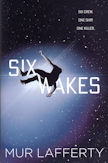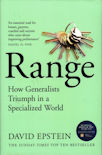David Epstein.
Range: how generalists triumph in a specialized world.
Pan. 2019
We have all heard about the 10,000 hour rule: that to become an expert, it takes this much repetition and practice. So it seems to make sense that the best way to achieve that expertise is to get a good head start: start young, and to focus. Epstein picks apart that advice here. He has two main arguments, illustrated with copious anecdotes, about why range, or breadth of practice, is just as necessary as depth.
First: 10,000 hours is a long time, requiring a lot of dedicated work. So, you need to be engaged with the topic: if you have not instantly picked your specific area (chess, golf, piano, whatever), you should spend some time surveying the field to discover what you want to do. Epstein give examples of world class sports people who engaged in several different sports initially, and world class musicians who played several instruments at first, before they focussed on one. These people at least had a field, and were just deciding which particular subgenre was for them. He also gives examples of people who tried a much broader range of occupations before discovering their vocation: flitting from job to job, never succeeding, giving up and moving on, until finally they found their life’s work; van Gogh is the best known example given here.
Second: the fields where 10,000 hours of focussed practice works are relatively simple: the practitioner gets immediate feedback on how successful they are, and the topic is constrained, so it is clear where to focus the effort and expertise. However, many disciplines today involve wicked problems: there are no immediate or clear markers of success, the boundary of the problem is ill-defined, and expertise can become constraining, limiting the solution approaches considered. In these circumstances, breadth of experience is an advantage.
Some depth is also needed, of course: too much breadth, and you end up knowing nothing about everything, as opposed to too much depth, where you know everything about nothing. So what are needed are T-shaped people: depth in some area, but breadth across areas, too. I am interesting in interdisciplinary working, and also use this metaphor of T-shaped expertise: in successful interdisciplinary teams, the ‘arms’ of the T join up to bridge between the different areas of expertise.
The book is engagingly written, with many fascinating examples, and covers a broad range of ideas, from the Flynn effect of increasing IQ, to where outsiders have provided insight, to why too much grit may not be a good idea. This latter example discusses a problem with many suggested techniques for success: survivor bias. ‘All CEOs do X’, trumpet these works, implying that if you simply also do X, you too can become a CEO. But to evaluate this claim, you also need to know how many unsuccessful people also do X. After all, presumably all CEOs brush their teeth, eat food, and wear clothes, yet these are not the (sole) reasons for their success. In the case of grit, the successful people studied have indeed grittily persevered, yet Epstein provides examples of others who instead gave up, yet also succeeded, just in something different that fits them better.
And, of course, this book itself also suffers somewhat from survivor bias: showing successful people who nevertheless flitted from job to job before their final success again does not imply that flitting from job to job will result in success. However, there is much interesting material here, and certainly it paints an interestingly different picture from the more mainstream view of the need for specialisation.
For all my book reviews, see
my main website.










